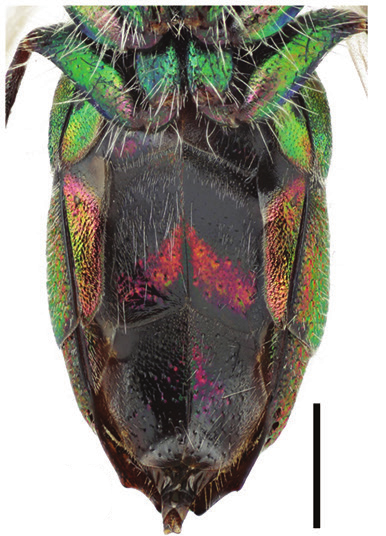Chrysis bicolor
- Innhold
- Diagnosis
- Distribution
- Biology
Diagnosis
Figure 110
Metasoma, ventral view: Chrysis bicolor ♀. Scale 1 mm.
Figure 138
Head, lateral view: Chrysis bicolor ♀. Scale 1 mm.
Length 5–8 mm.
The species resembles C. illigeri, but the malar space is shorter (Fig. 138), the punctation of T2 is denser and the metascutellum is more raised in profile. Also the black spots of S2 are posteriorly more oblique in the female (Fig. 110). The head and mesosoma are mainly blue or greenish, but the mesoscutum and anterior margin of the pronotum are red or golden red in the female and golden green to greenish in the male. The mesoscutum is usually darkened medially in the male. The metasoma is mainly red in the female and golden greenish in the male with a greenish, bluish or black apical rim. T2 often has a black patch dorsally in the female.
Distribution
Denmark, Estonia, Finland, Latvia, Lithuania, Sweden. Relatively rare.
Trans-Palearctic: Europe, northern Africa, Russian Far East (Kimsey and Bohart 1991, Kurzenko and Lelej 2007).
Be aware that the records present in the GBIF map may be misleading for some countries due to unrevised data sets or missing information.
GBIF Taxon: Chrysis bicolor Lepeletier, 1806Biology
Habitat: sparsely vegetated sandy areas. Adults occasionally visit flowers of Apiaceae, Asteraceae, Euphorbiaceae and Rosaceae (Linsenmaier 1997, Rosa 2004, 2006, our own obs.).
Flight period: early June to late August.
Host: Tachysphex obscuripennis (Schenck) and T. pompiliformis (Panzer) (Crabronidae) (Morgan 1984, Saure 1998, Wickl 2001). In central and southern Europe also Dinetus pictus (Fabricius) (Crabronidae) (Gauss 1967).

